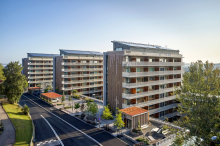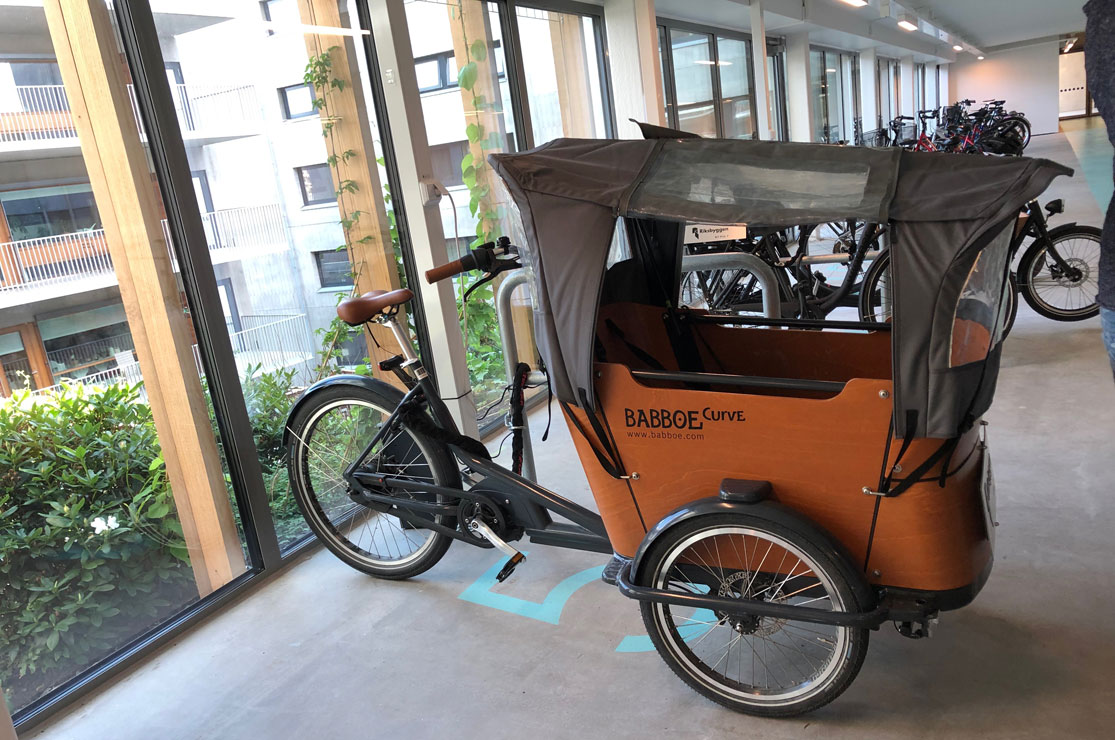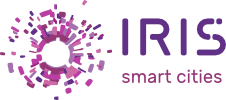 In order to nudge the residents of its new apartment building towards a more sustainable lifestyle, Swedish housing company Riksbyggen made the bold choice to not offer them any private parking spaces. Instead, they were offered a comfortable alternative through a new mobility concept, developed within the IRIS Smart Cities project.
In order to nudge the residents of its new apartment building towards a more sustainable lifestyle, Swedish housing company Riksbyggen made the bold choice to not offer them any private parking spaces. Instead, they were offered a comfortable alternative through a new mobility concept, developed within the IRIS Smart Cities project.
Located in a steep slope at the edge of a green recreational area in the central parts of Sweden’s second largest city, Gothenburg, Housing Association Viva was built as a flagship for the initiative, Positive Footprint Housing. The initiative is a multidisciplinary platform where Riksbyggen, together with academic and public partners, aim to push forward the boundaries of sustainable building and living from a holistic approach, including social and economic as well as ecological sustainability.
“Building a house that was car-free was an important part of our sustainability ambition and something we made very clear to potential apartment buyers from the beginning. We never experienced that the lack of private parking spaces was a big issue for them, maybe because we also communicated that there would be alternative mobility solutions,” says Charlotta Brolin, sustainability expert at Riksbyggen.
“Viva was a pilot also for the City of Gothenburg in the sense that Riksbyggen was allowed to build homes without the 0,5 – 0,2 parking spaces per household usually required. That’s probably also something that made the building possible at all, since it would have been very difficult to fit an underground parking in this location,” says David Backelin at the City of Gothenburg’s Urban Transport Administration.
In parallel with the building process, completed in 2018, Riksbyggen collaborated with the transport consulting company Trivector in the EU-funded project IRIS Smart Cities, where Gothenburg is one of three European Lighthouse cities tasked with developing, testing and ultimately replicating innovative solutions in the areas of energy, mobility and ICT. IRIS Smart Cities thus created the opportunity for Trivector to develop and implement its mobility service EC2B in a pilot in Viva, run by Trivector’s subsidiary EC2B Mobility.
The EC2B concept packages a wide range of mobility options within the same mobile app, that is made available to the residents of Viva. As moving into a new home is identified as an appropriate time to implement new mobility habits, EC2B also offers the residents opportunities for personal mobility advice and support as well as demonstration events where the different vehicles can be tried out.
“We’ve used the residents of Viva a little bit like guinea pigs in this experiment and it has been incredibly valuable for us to test this in real life and to be able to collaborate with the users in order to develop the service.” says Lennart Persson, CEO of EC2B.
All mobility options in one app
In the large bicycle room, where tall windows provide an attractive view of the courtyard and balconies of Viva, residents keep their private bikes and have access to a common tool room where reparations and up-keeping can be made. This is also the home of the electric bikes (both regular and cargo) that are available to the residents free of charge through the EC2B booking system. Keys are kept in a digital key box that also opens through the app. The app is also connected to the electric car-pool with three cars parked in front of the building. Residents pay for the time they use the cars.

“The bikes are provided through the company Goride and the cars by Our Green Car. To use procurements with different providers is a strength in our business model, where we can have an attractive offer for residents as well as for the mobility companies”, says Lennart Persson.
Unique for the EC2B concept is that it also allows users to buy tickets for public transportation, through a collaboration with the public transport company Västtrafik. It is the first time a Swedish public transport company allows digital tickets to be bought through an app of a private company. Riksbyggen initially offered users of the EC2B app discounted ticket prices to encourage people to get started with the service.
Learnings from the pilot
EC2B being a pilot of the concept Mobility as a Service (MaaS), it was of great importance to find out how it was accepted by its users and if/how it changed their habits. That’s why surveys were conducted before the launch as well as a year after.
The first survey went out to all individuals who had signed up for one of the 132 apartments in Viva in late 2016. The response rate was 47 percent. It showed that while many of the buyers were attracted by Viva’s sustainability ambitions, the central location seems to have been the most convincing argument. Just over half of the respondents say that access to a mobility pool was important for their decision.
Before moving into Viva, a private car was a frequent mode of transportation for the respondents. However, many said that they planned to sell their cars prior to the move. Together the respondents planned to sell 19 out of totally 58 cars. When asked the same question in a second survey a couple of weeks before moving into Viva, the response from 32 respondents showed that they together planned to reduce the total number of cars from 28 to 7 – a significantly larger reduction compared to the first survey.
A search in official registers shows that the 170 adults who has their registered address at Viva, together own a total of 32 cars. That equals 0,18 cars per person, which is a higher number than what was expected, considering the lack of parking lots, but lower than the corresponding number for the whole city of Gothenburg which is 0,28 cars per person.
“That Viva is not yet a one hundred percent car-free housing association is not very surprising. The force of habit is strong, and people need both nudging and a comfortable way to make the sustainable choice. For example, we see that we need to offer a priceworthy option for those who use their cars to go to their summer houses on the weekends.”, says Lennart Persson, CEO of EC2B.
Worth noting is also that those who still own a car and has arranged parking in other locations in the area, generally use it less than before and tend to do more errands at once due to the fact that the car is parked further away from the home. Compared with surveys on mobility habits in the whole city of Gothenburg, the brf Viva residents only do half as many travels by car as the average Gothenburg resident.
Results after a year of using EC2B
So how was the service EC2B used the first year? Data from the booking app show that regular two-wheeled electrical bicycles were the most popular, with a peak during summer months when they were booked as much as 200 times per month. This put a high demand for maintenance of the bikes, which needs to be budgeted for. The three-wheeled cargo bikes were, in contrast, used evenly throughout the year and booked around 25-30 times monthly. The two-wheeled bikes were booked more during weekdays while the cargo bikes were used more during weekends.
Second to walking, public transport was the most common mode of transportation among the survey respondents. Sales of public transport tickets through the EC2B app had a peak with almost 200 sold tickets per month in the summer of 2019 when Riksbyggen in a limited campaign offered the Viva residents a 25 percent ticket price reduction. When the campaign was over the users seem to have gone back to using Västtrafik’s own app for buying public transport tickets.
Asked how often they use the EC2B app, most respondents answered once per month while 25 percent said they use it on a weekly basis. While the cargo bikes were mostly used for shopping, the two-wheel electrical bikes were used for commuting to work and school, work related errands and visits to friends and family. Car sharing cars were used for a variety of personal errands, shopping and leisure activities, but also for commuting to work and school. However, travels with car sharing cars are significantly fewer and shorter than travels with private cars.
Change takes time
With continuous dialogue with the residents of Viva the EC2B mobility service keeps being developed and adjusted according to the behaviors and needs of the users. Based on the Viva model, a second pilot has also been initiated offering a mobility service for work-related travels to employees working on a university campus area nearby.
In summary, the residents of Viva have appreciated the mobility service and have to a large extent changed their mobility habits, but far from all have given up their private cars. A radical change takes time to be established. Mobility services are new to the market and in the phase of trial and error, when trying to coordinate and package a wide range of different services offered by different actors.
“We follow the continuous use and development with great interest. Especially when it comes to owning cars, we might see a bigger change in a couple of years when people have gotten more used to the shared services. We already see that the cars parked in other locations are used less,” says Charlotta Brolin at Riksbyggen, who now include car- and bikepools in the planning of many of its city-close buildings.
“There is a paradigm shift going on, moving away from a society and urban development that since the 1950’s has been very centered around the car. It’s not done overnight, but in the seven years I’ve worked with parking issues I have seen a clear shift in the attitudes of property owners who are now much more willing to offer different kinds of mobility services in order to lower the required amount of parking lots,” says David Backelin at the City of Gothenburg’s Urban Transport Administration.
“I think many property owners are feeling a sense of urgency that if they don’t get onboard now, they risk missing the train. Shared mobility is the way forward and will eventually be a natural part of the urban lifestyle,” concludes Lennart Persson, CEO of EC2B.
IRIS Smart Cities in Gothenburg
IRIS is a five-year EU project that started on October 1, 2017. Within the project, new solutions for urban development within the areas in energy, mobility and ICT (Information and Communication Technology) are being tested. Three cities, which are considered to have come a long way in these areas, are selected as so-called “Lighthouse cities” – Utrecht (Netherlands), Nice (France) and Gothenburg.
Four follower cities are also participating: Vaasa (Finland) Alexandroupolis (Greece) Santa Cruz de Tenerife (Spain) and Focsani (Romania). The idea is that the follower cities will learn from and be able to use the solutions that are developed within the Lighthouse cities.
In total, 43 organisations from 9 countries collaborate to accelerate smart and sustainable solutions and behaviours. Eleven partners participate in Gothenburg: Johanneberg Science Park coordinates the project on behalf of the City of Gothenburg and additional partners are thefollowing: Akademiska Hus, Chalmers, HSB, IMCG, Metry, Trivector, Tyréns, Riksbyggen and RISE.
11 Feb 2021

